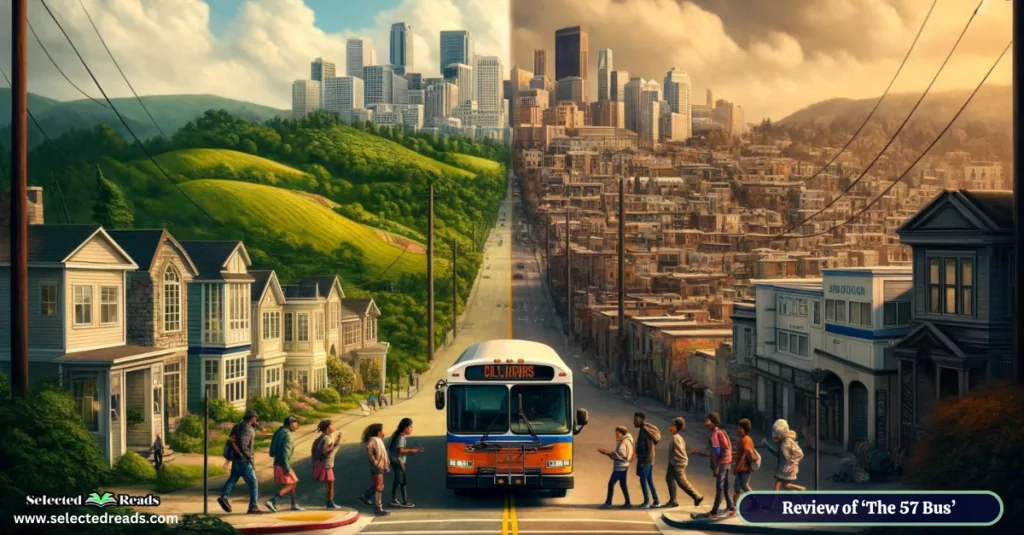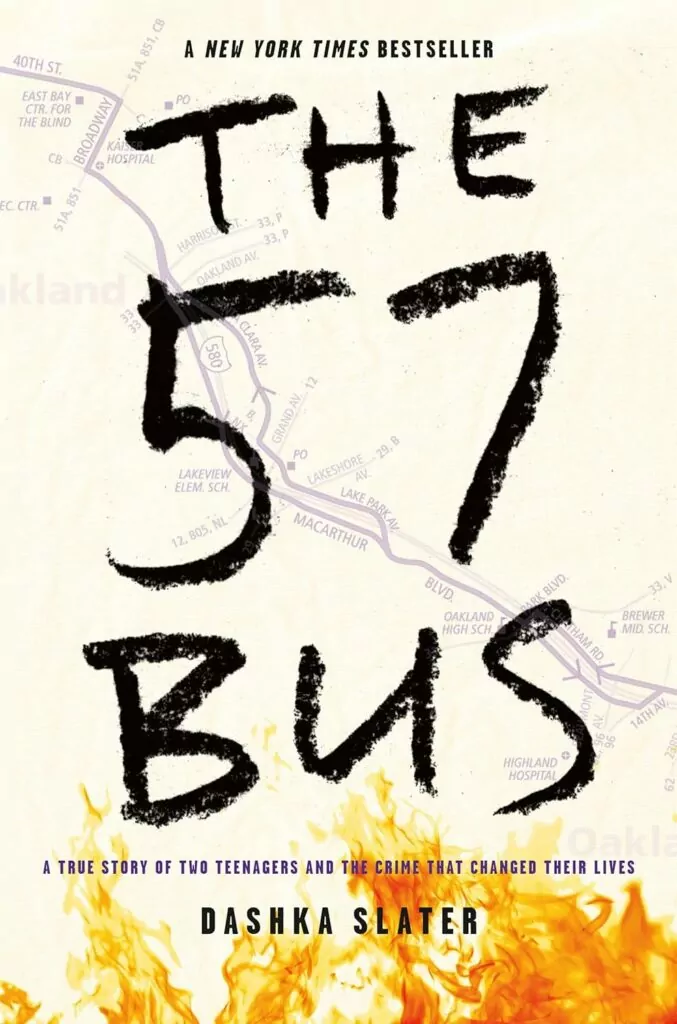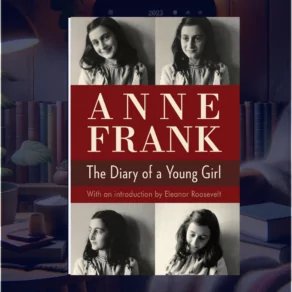Today we turn our attention to “The 57 Bus” by Dashka Slater, a compelling piece of nonfiction that deftly navigates the intersection of true crime and social commentary. Positioned within the genres of young adult and LGBTQ+ nonfiction, this book offers a deep dive into themes of race, gender identity, and the complexities of the juvenile justice system.
The goal of this post is to acquaint you with the core elements of “The 57 Bus,” providing a clear overview while preserving the book’s narrative surprises. My discussion is structured to enhance your understanding and engagement with the text. Initially, I will provide an extended summary of the book, focusing on its plot and factual basis.
Following this, I’ll delve into an analysis of the main characters, exploring their backgrounds and the roles they play in the unfolding events. To conclude, I will present some thought-provoking questions suitable for book club discussions or individual contemplation, designed to stimulate deeper reflection on the book’s key issues.
The 57 Bus Summary
“The 57 Bus: A True Story of Two Teenagers and the Crime That Changed Their Lives” by Dashka Slater recounts a deeply impactful true story that unfolds on a city bus in Oakland, California. The narrative weaves together the lives of two high school students from markedly different backgrounds, whose lives intersect tragically on the 57 bus.
Sasha, an agender teen who prefers the pronoun “they,” is raised in a middle-class, supportive family in the foothills of Oakland. They attend a small, private school and are known for their brilliant mind and quiet nature. Sasha’s life is one of relative comfort and understanding, a stark contrast to the world of the other protagonist.
Richard, a Black teenager, comes from the challenging economic environment of Oakland’s flatlands. He attends a large public school and struggles with the societal pressures and limitations imposed by his surroundings. Richard’s life is complicated by economic hardship and the community’s interaction with crime and justice.
Photo: Amazon
One fateful day, as both teens ride the 57 bus, their worlds collide in the most harrowing way. Sasha, wearing a skirt, is asleep on the bus when Richard, influenced by peers and seeking approval, flicks a lighter to Sasha’s skirt. The skirt catches fire, leaving Sasha with severe burns. The incident, which lasts only a moment, has long-lasting repercussions for both teenagers.
Richard is arrested and charged with two hate crimes. His actions, initially perhaps seen as a thoughtless prank, place him at the center of a legal battle that could end with him in prison for life. The story unfolds to reveal a complex tapestry of juvenile justice, racial dynamics, and the intersections of gender identity and socioeconomic status.
The book delves into the aftermath of the attack, exploring how it affects not only Sasha and Richard but also their families, communities, and the city at large. It challenges the reader to think beyond black-and-white notions of right and wrong, delving into the gray areas of human behavior, legal justice, and societal expectations.
Throughout the recounting, Slater uses court documents, interviews, and a host of other sources to give a comprehensive view of the circumstances that led to the crime and its consequences. Both Sasha and Richard’s lives are portrayed with depth and empathy, showing how a single moment can alter lives forever.
In the broader context, “The 57 Bus” serves as a poignant exploration of important themes such as race, class, gender, crime, and punishment, making it a vital read for those looking to understand more about these crucial societal issues.
Related: Last Night at the Telegraph Club Summary
The 57 Bus Summary Discussion Questions
Here are some thought-provoking questions that could be used in a classroom setting, book club, or even for personal reflection:
- Exploring Identity: How does Sasha’s identity as agender influence their experiences both before and after the incident on the 57 bus? How does the book challenge or reinforce your understanding of gender identity?
- Social Environment and Behavior: In what ways do the social and economic environments of Richard and Sasha shape their daily lives and decisions? Discuss how their backgrounds might have contributed to their encounter on the 57 bus.
- Justice and Empathy: What are the challenges of applying the law in cases involving juveniles like Richard? Discuss whether you believe the legal actions taken were just. How does the book encourage readers to empathize with both Richard and Sasha?
- Media Representation: How does media coverage affect public perception of the crime in the book? Discuss the role of media in shaping narratives around crime and identity.
- Restorative vs. Punitive Justice: The book presents a complex situation that blurs the lines between victim and perpetrator. How might restorative justice have looked in this case? Would it be more appropriate than punitive justice for Richard, Sasha, or both?
- Impact of Peer Influence: Analyze the role of peer pressure in Richard’s decision to light Sasha’s skirt on fire. How does the book portray the influence of peers in shaping behavior?
- Education and Awareness: What could schools and communities do to foster understanding and respect for diverse identities like Sasha’s? Discuss any measures that might prevent such incidents in the future.
- Forgiveness and Reconciliation: Both families react differently to the incident. What are the various facets of forgiveness shown in the book? Discuss whether you think reconciliation is possible or appropriate in such cases.
- Intersectionality: How does the book address the intersectionality of race, gender, and class? Discuss how these intersecting identities impact the lives of Richard and Sasha differently.
- Author’s Purpose: What do you think was Dashka Slater’s purpose in writing “The 57 Bus”? How successfully does she fulfill this purpose through her storytelling?
Final thoughts
To conclude, I hope you’ve found this overview of “The 57 Bus” engaging and insightful. This book is a poignant exploration of critical social themes, woven through the real-life narrative of two teenagers whose lives intersect with lasting consequences. If you haven’t yet delved into “The 57 Bus,” I highly recommend picking it up. It’s not only a crucial read for those interested in the intersections of identity and justice but also a powerful narrative that challenges our perceptions of morality, legality, and empathy.







